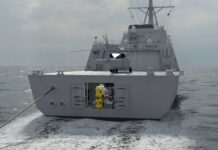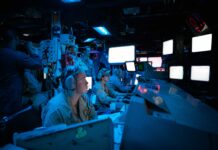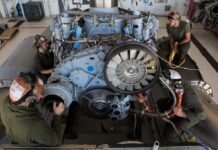The US Navy intends to field its first offensive hypersonic weapon in 2025. These sea-launched boost-glide missiles will enable the globally-dispersed fleet to strike almost any target in the world with conventional warheads, within a one-hour timeframe.
In 2018 the Pentagon tasked the US Navy (USN) with developing an intermediate range offensive hypersonic missile to serve as a basis for service-optimised weapon systems for both the USN and the US Army. The Navy’s hypersonic weapon is designated the Conventional Prompt Strike (CPS) system, while the Army’s is known as the Long-Range Hypersonic Weapon (LRHW). Each service will field the missile in service-specific launch containers, and integrated into service-specific fire control systems, but both will utilise the same All-Up-Round (AUR) being developed by the USN. The fully assembled missile or AUR will consist of a two-stage solid fuel booster rocket topped by the unpowered Common Hypersonic Glide Body (C-HGB) which carries the non-explosive, kinetic-energy-projectile warhead. The booster stages will have a diameter of 82.5 cm. The AUR’s total length appears to be circa 12 m, judging from US Army illustrations depicting the LRHW launch container aboard 13.8 m long Transporter Erector Launcher (TEL) trailers.

Credit: US Army
CPS Concept and Profile
The Navy initiated the CPS programme of record in 2019, choosing Lockheed Martin as lead contractor to design, develop and construct the weapon system. Northrop Grumman was tasked with developing the boosters, while Dynetics Technical Solutions received an initial contract to build 20 C-HGB modules for both services.
The CPS is conceived as a hypersonic boost-glide missile. The booster rocket will accelerate the Hypersonic Glide Body (HGB) to hypersonic speeds, reaching an apogee of circa 100 km above sea level. The unpowered HGB will detach from the spent booster and descend quickly, retaining hypersonic speed as it glides towards its target. It will approach its target at relatively low altitude to fly under air- and missile defence sensors until late in the attack run. Unlike ballistic warheads, the HGB will remain fully manoeuvrable, changing course as needed to avoid detection, evade interceptors, and exploit terrain to mask its approach.
The precise speed envisaged remains classified, but by definition a hypersonic weapon achieves speeds of Mach 5 or more. Range is also classified, but the CPS is generally assumed to have a similar range as the US Army’s LRHW, or more than 2,775 km.
While the CPS (like the other hypersonic weapons programmes currently pursued by the US armed forces) will be armed with a conventional warhead, it is being developed under the purview of the Navy’s Strategic Systems Programs (SSP) office. Given the weapon’s global reach, speed and the ability to engage high value targets it is considered a strategic asset, said SSP’s director, Vice Adm. John Wolfe. The new weapon is supposed to provide flexibility and tactical/strategic options to the fleet. With CPS-armed ships deployed around the globe, the USN will be capable of striking almost any point on Earth within an hour of launch. The hypersonic missiles can be launched from well outside enemy exclusion zones, such as anti-access/area denial (A2/AD) zones, which is considered especially advantageous in the Indo-Pacific region. Submarine-based CPS can be launched significantly closer to enemy shores, including from within the A2/AD zone, further shortening flight time or attacking targets deep inland. However, hypersonic missiles will augment, not replace, the current missile arsenal; each CPS armed vessel will carry only a small number of hypersonic missiles. In practice, the complex and expensive missiles will be reserved for long-range, time-sensitive or strongly defended high value targets, and to eliminate A2/AD barriers such as air-defence or anti-ship-missile installations in order to open attack corridors for more conventional weapon systems.

Credit: US Navy
Operational Platforms
The CPS will be fielded aboard Zumwalt class (DDG 1000 class) guided missile destroyers and aboard Virginia class (SSN 774 class) attack submarines. Deploying the weapon from a surface ship will require a so-called ‘cold start’ in which the missile is expelled from the launch tube by a gas generator before firing the weapon’s engine. Submarine launch is even more demanding, as the gas pressure must be strong enough to propel the missile out of the water before booster ignition. “Our first challenge was: Can we develop an air launch? Basically pressurised air to get that weapon out of a Zumwalt, right up in the air, so it lights off and we don’t have all those hot gases [to deal with]. We’ve actually proven that we’ve done that testing … The next challenge is build the underwater launch,” Adm. Wolfe said.
Zumwalt Class
On 17 February 2023, Lockheed Martin announced that they had received the full-scale contract to integrate the CPS weapon system on the Zumwalt class destroyers. The initial contract awarded in February is valued at USD 1.1 Bn. If all options under the contract are exercised, the total value will rise to USD 2 Bn. The contract will build on the early design work already being conducted by Lockheed Martin under a 2022 contract. Under the new award, Lockheed Martin – acting as general contractor – will provide launcher systems, weapon control, AURs, and platform integration support for the Zumwalt class. According to the Lockheed press release, the company, along with industry partners Northrop Grumman and General Dynamics Mission Systems, “is on track to provide the CPS surface-launched, sea-based hypersonic strike capability by the mid-2020s.”
Already in January 2023 the Navy awarded Huntington Ingalls Industries (HII) a USD 10.5m contract to prepare the modernisation work on USS Zumwalt (DDG 1000) and USS Mansoor (DDG 1001). The planning phase of the modernisation project is to be completed by December 2023. Work will begin in early 2024 at HII’s Shipbuilding Division facility at Pascagoula, Mississippi during the destroyers’ regularly scheduled maintenance availabilities. USS Zumwalt enters its maintenance availability in October 2023 and will be converted first, followed by the Mansoor. The third destroyer, USS Lyndon B. Johnson (DDG 1002), will be outfitted with the CPS several years later, pending the next scheduled maintenance availability.

Credit: Lockheed Martin
Installing CPS will require significant modification of the destroyers, including the removal of both 155 mm gun turrets. This will permit installation of four Large Missile Vertical Launch System (LM-VLS) modules on the foredeck, two each on the starboard and port sides. Each LM-VLS is 2.2 m in diameter and can accommodate three AURs, for a total of 12 hypersonic missiles per ship. In addition to the gun turrets, all the associated munitions and support facilities will be removed to make room for the VLS modules and the cold-launch gas system to propel the AUR clear of the ship before firing the booster motor.
“We’re going down about five platforms to accommodate the height of the missile, which is significantly larger than other missiles in the inventory,” said DDG 1000 programme manager Capt. Matthew Schroeder in March 2022. General Dynamics Bath Iron Works will produce the LM-VLS. The firm received a contract in August 2022 to procure long-lead materials, and is expected to deliver the modules by June 2024.

Credit: US Navy
Installing the LM-VLS modules is only a first step. Integrating the hypersonic weapons into the ship’s combat system is considered a major challenge. Captain Tyson Young, program executive officer (PEO) for the Zumwalt Integrated Combat System, is responsible for managing the modification process to enable deployment of hypersonic weapons aboard the class. Addressing the American Society of Naval Engineers on 1 February 2023, Young explained the additional procedures being planned by the Navy, beyond the structural modifications. “We’re integrating an underwater weapons control system with TSC [tactical support center] control in order to affect the data and message transfer to launch the missile. We’re virtualising both sets of control systems. My integrated combat system and our TSC […] are going to do lab testing next month and then we’re going to do an onboard ship demo both in port and underway,” Young stated.
Virginia Class
Following completed integration of the CPS on the Zumwalt class, the Navy plans to add hypersonic weapons to the Block V variant of the Virginia class attack submarines. Beginning with the second vessel, the Block V configuration will be outfitted with the Virginia Payload Module (VPM), a 25.5 m long section being inserted mid-hull, increasing the new attack boats’ overall length to 141.5 m. The VPM will be outfitted with four in-line large-diameter launch tubes, each of which can accommodate three hypersonic weapons for a total of 12 CPS per boat. Alternately, the tubes can carry and deploy seven cruise missiles per launch tube, as well as unmanned underwater vessels (UUVs), UAVs, and special operations gear.

Credit: General Dynamics Electric Boat
Adm. Wolfe stated in November 2022 that the Navy is constructing an underwater testbed for launching CPS prototypes from a VPM-representative module; it will support development of launch procedures by permitting scientists to study the hydrodynamics of the missile as it transits from the launch tube to the surface. “We’re starting to build a facility to do underwater launch testing, so that we understand what that weapon will do, even before we get to the first Virginia [class vessel],” Wolfe told reporters on the sidelines of the Naval Submarine League symposium on 2 November 2022. The new facility will benefit from experience with existing testbeds used to develop underwater launch techniques for Tomahawk cruise missiles and Trident missiles.
Developmental Testing Progress to Date
Through 2022 the Navy has invested USD 2.6 Bn in CPS development and testing. An additional USD 1.2 Bn have been requested for 2023. The Navy is pursuing a three-step CPS acquisition programme aimed at developing fieldable prototypes and enabling a transition to production. Phase 1 is currently in progress. It consists of a Middle Tier of Acquisition (MTA) Rapid Prototyping programme to develop and demonstrate a hypersonic, cold-gas launched prototype capability. Phase 2 will be the MTA Rapid Fielding phase to introduce CPS on a Zumwalt class destroyer. The third and final phase will transition CPS to a major defence acquisition programme at Milestone C. This will lead to fielding the hypersonic weapon on the Virginia class SSNs and on the remaining Zumwalt class vessels.
The USN devised a master test strategy (MTS) for Phase 1 in 2019. In June 2021 the programme was placed under oversight of the Pentagon’s central Director of Operational Test and Evaluation (DOT&E), although the actual testing cycle is still being conducted directly by the Navy. While the Pentagon is seeking to establish the hypersonic weapons capability as rapidly as possible, the testing cycle is moving deliberately step-by-step. The C-HGB was successfully tested in March 2020 by launching it via a conventional booster rocket from the Department of Defense’s Pacific Missile Test Range in Hawaii. In 2021 the two solid rocket motor stages of the AUR booster were successfully fired in separate ground-based events at Northrop Grumman’s testbed in Promontory, Utah. These three events paved the way for a series of flight tests of the full AUR.

Credit: Lockheed Martin
Testing the complete AUR is being conducted jointly by the Army and the Navy through the Joint Flight Campaign (JFC). The goal of the Phase 1 test strategy is to demonstrate an operational capability of the AUR prototype utilising mission-relevant scenarios. The first joint AUR prototype-capability flight test (JFC-1), which was conducted in June 2022 from the Pacific Missile Test Facility in Hawaii, failed due to an unspecified in-flight “anomaly.”
Both booster stages fired successfully during the test, but the HGB did not reach its target because of an integration issue (which the Pentagon has declined to describe in detail). The Navy announced that it found and corrected the flaw within two months of the test, clearing the way for further JFC events.
Despite the USN’s generally optimistic tone regarding the programme’s progress, the Pentagon’s testing office has expressed some scepticism. According to the DOT&E’s Fiscal Year 2022 Annual Report, which was released in January 2023, “the alignment of weapon system requirements to flight test objectives across all three phases of the programme is not yet mature.” Current testing continues to focus on flight performance. Neither the ground-based hypersonic-acceleration sled tests nor the flight tests performed to date incorporated operationally representative targets, notes the report. The same holds for the currently scheduled tests, which limits the collection of reliable lethality data. The report acknowledges that the USN is currently updating the MTS to address programmatic changes and additional performance metrics. These changes will be subject to approval by the Pentagon’s testing director.
As the DOT&E notes, flight performance is only one aspect of hypersonic weapon development. Major remaining challenges include developing innovative materials that can withstand extreme environments, and heat-shielding for the outer materials as well as for onboard electronics at sustained temperatures reaching 1,650 degrees Celsius. The impact of such temperatures on aerodynamic performance is also still being studied. As part of this effort, the Navy – in partnership with the Army and other agencies – employs sounding rockets carrying experimental payloads to provide data on the performance of materials and systems in a realistic hypersonic environment. As described by the USN, precision sounding rocket launches fill a critical gap between ground testing and full system flight testing, and support rapid maturation of offensive and defensive hypersonic technologies.

Credit: US Navy
Test and Evaluation Going Forward
Joint Army-Navy hypersonic missile flight tests are expected to continue through 2028, while each service simultaneously conducts its own parallel testing programme. Four additional JFC test events are planned through March of 2024. Tests JFC-2 and JFC-3 will be geared toward the Army’s operational profile, while JFC-4 and JFC-5 will focus on demonstration of the CPS’ cold-launch capability. These future JFCs will require an additional update to the MTS. The Navy intends to provide an overall test strategy with alignment of planned missile flights to the planned advances in missile capability for each phase of CPS delivery, including re-evaluation of performance and test objectives. This update should be presented by early FY2024.
Here, again, the DOT&E report criticises the planned approach as too narrow, stating that the Navy has yet to identify test conditions and associated test resources to be evaluated across the three CPS phases “to adequately assess lethality, [survivability] and operational effectiveness in the threat-contested environment. The Navy is considering inclusion of the threat-contested environment in Phase 1 testing, but has yet to commit due to developmental test requirements. These data are necessary to validate and use model and simulation for operational testing, and delays in data collection could increase operational test cost in later CPS phases.”
Furthermore, the DOT&E criticises the Navy’s failure (to date) to demonstrate the effect of a contested environment on CPS prototype performance. For Phase 1, the service intends to utilise a combination of flight environment modelling and simulation, component testing in a simulated environment, and a full hardware-in-the-loop evaluation to approximate the effect of a contested environment on the CPS prototype’s performance. DOT&E notes that “the Navy has yet to provide an overarching strategy to assess CPS performance in contested environments across all three phases of acquisition, risking an inefficient test design across the three phases and the potential need for unplanned test resources in Phases 2 and 3.”
Notably, the five planned JFC flight tests are all associated with CPS Phase 1. The Navy has not yet modelled a testing strategy to support programme Phases 2 and 3, although flight testing from the Zumwalt in 2025 has already been tentatively scheduled. The DOT&E cautions that the Phase 1 CPS prototype is insufficiently mature to assess suitability metrics, and that the office will not present its assessment of the CPS prototypes’ capabilities and limitations until completion of the Phase 1 flight tests in FY2024; the comprehensive report on the CPS operational effectiveness will be presented following conclusion of Phase 3 testing in FY2029.
Fielding
While the Navy has set specific timelines for fielding the CPS, the programme – like all other US hypersonic weapons projects – currently remains at the prototyping stage. A decision to proceed to an acquisition programme will not take place until the prototype testing verifies the technological and operational maturity of the weapon system, presumably not earlier than 2029.

Credit: US Navy
This will not stop early fielding efforts. The service plans to deploy an operationally capable prototype aboard USS Zumwalt in 2025, and conduct a live-fire test at sea by December of that year. The ship will then continue to serve as the platform to certify the operational capability of the hypersonic weapon’s deployment from the surface vessels. The Navy hopes to achieve full operational capability of the CPS on the first Virginia class vessel beginning in 2029 (the original goal was 2028, but this was deferred because of delays completing the first VPM-equipped submarine).
Even after achieving full operational capability, CPS will remain a niche asset. A January 2023 Congressional Budget Office (CBO) report cites Pentagon plans to acquire 240 CPS missiles (at an estimated unit cost of USD 41 M). The weapons are ultimately to deploy on three Zumwalt class destroyers and 19 Virginia class submarines (Block V plus the planned Block VI and Block VII variants), for a total of 22 CPS-capable platforms. However, the total production run of Virginia Block V through Block VII will not be in service until the late 2030s (if the Block VI and VII are actually procured as planned). The relatively small CPS-capable flotilla should not, however, diminish the strategic value of the weapon system. Realistically, truly ‘global’ reach is irrelevant for a strategic asset, as threats warranting their deployment will tend to emanate from a relatively small number of hostile actors.
Furthermore, CPS is not intended to be the US military’s sole hypersonic asset. Operating in coordination with land-based and airborne assets also being developed, CPS will form one leg of a new, conventionally armed but hypersonic strategic triad.
Sidney E. Dean












